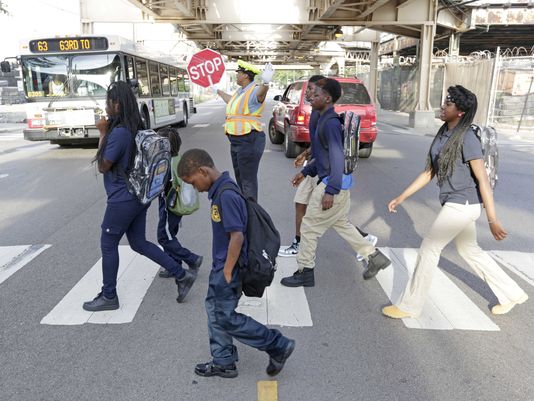Surgeon General Vivek Murthy has a prescription for the poor state of American health: a brisk walk.
With half of Americans suffering from a chronic disease – and two-thirds overweight – Murthy wants the USA to make walking a priority.
“I’m asking for individuals and communities across America to reclaim the culture of physical activity that we once had,” said Murthy, who released a “call to action” on walking Wednesday. “It’s not just a call for individuals to walk more, but for all of us to make communities more walkable.”
In many parts of the USA, going for a walk isn’t as simple as it sounds, Murthy said.
Murthy’s report calls on communities to address issues that prevent people from being able to walk in their neighborhoods, from lack of street lighting to dangerous traffic and crime.
In sprawling suburbs, people depend on cars because their homes are located too far away from stores, schools or workplaces for people to walk. In urban centers, homes and businesses may be densely concentrated, but neighborhood crime makes people afraid to walk, Murthy said.
“How your community is planned really has a lot to do with how healthy you are,” said Anna Ricklin of the American Planning Association. “You can’t blame a child for not walking to school if there is not a safe way to walk to school. If there aren’t parks and open spaces, it’s hard to go play. In rural areas, they may be very car dependent, and there are not a lot of places to walk to.”
Three in 10 people live in communities without adequate sidewalks, he said. In surveys, parents say that the biggest barrier to allowing their children to walk to school is the distance that kids would have to travel.
Improving pedestrian safety is important, said Murthy, who noted that 66,000 pedestrians are injured in traffic accidents every year and more than 4,700 are killed.
In many parts of the country, weather keeps people from walking, said Andrea Cheville, a professor at the Mayo Clinic in Rochester, Minn., and director of the cancer rehabilitation program. In northern climates like hers, Cheville said, icy temperatures and slippery roads can make walking dangerous. In the South, the heat can make walking dangerous for older people. These communities may need to open up schools, rec centers and malls for walking, she said.
Only half of Americans get the recommended amount of physical activity – at least 150 minutes a week of “moderate intensity” aerobic exercise, such as brisk walking, or 75 minutes a week of vigorous exercise, such as bicycling or jogging, Murthy said.
Only about one in four high school students got at least an hour of exercise a day, the recommended amount for children and adolescents.
These people are losing out on walking’s health benefits, Murthy said.
In the landmark Diabetes Prevention Program, led by the National Institute of Health, people who lost 7% of their body weight and walked 150 minutes a week cut their risk of developing diabetes by more than half.
“Being active doesn’t necessarily mean going to the gym or running a marathon,” said Robert Ratner, chief scientific and medical officer at the American Diabetes Association. “It just means walking half a hour a day, five days a week.”
This level of physical exercise also reduces the risk of breast and colon cancers, Cheville said.
In children, exercise can also strengthen muscles and bones; some studies show it can even lower levels of anxiety and depression, according to Murthy’s report. Research suggests that incorporating physical activity into the school day can improve students’ attention span and academic performance.
By itself, walking doesn’t burn a lot of calories or result in much weight loss. But studies show that people who exercise are more likely to keep weight off, Ratner said.
Exercise has other benefits, said David Ludwig, director of the New Balance Foundation Obesity Prevention Center at Boston Children’s Hospital.
Exercise improves a person’s metabolism, the way the body processes food. It makes the body more sensitive to insulin, a hormone that moves sugar out of the blood and into cells, reducing the risk of diabetes. Lastly, exercise builds lean muscle tissue, Ludwig said.
Encouraging people to walk more and drive less has environmental benefits, as well, reducing pollution and greenhouse gases, Murthy said.
Murthy acknowledged that the decisions that make cities walkable – from building parks to installing speed bumps – aren’t made in Washington, but at the most local level, by zoning boards, planning commissions and city councils.
Still, Ludwig said it’s important for someone of the Surgeon General’s stature to address obesity and physical inactivity.
“The Surgeon General is the nation’s leading doctor,” said Ludwig, director of the New Balance Foundation Obesity Preventive Center at Boston Children’s Hospital. “He commands tremendous visibility and respect.”
Cheville praised Murthy for focusing the USA’s attention on chronic disease.
“We have to do something as a country,” Cheville said. “Obesity is a pandemic. . . . There has never been a time in history when we have had so much food, so many calories readily available to us. It is killing us.”
Source: USA Today
September 9, 2015
By Liz Szabo, photo by M. Spencer Green / AP
http://www.usatoday.com/story/news/2015/09/08/surgeon-general-issues-call-action-tells-usa-start-walking/71879448/











